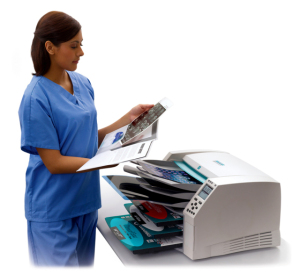by
Olga Deshchenko, DOTmed News Reporter | August 31, 2010
This report originally appeared in the July 2010 issue of DOTmed Business News
In medical dramas, actors in white coats ponder broken bones or baffling organ ailments displayed on large sheets of film glowing on a viewbox. But when the television is off, such scenes are rare.
With the health care industry in the digital era, it's no surprise that the dry imagers market in the United States is struggling.



Ad Statistics
Times Displayed: 136626
Times Visited: 7924 MIT labs, experts in Multi-Vendor component level repair of: MRI Coils, RF amplifiers, Gradient Amplifiers Contrast Media Injectors. System repairs, sub-assembly repairs, component level repairs, refurbish/calibrate. info@mitlabsusa.com/+1 (305) 470-8013
"It's declined considerably over the last several years," says Michael Kolberg, vice president of sales for Codonics Inc. "In the United States, the market has gone down relatively rapidly because of the use of more and more soft-copy reading and the proliferation of more PACS systems."
Manufacturers say that there isn't much room left for technological innovation in the advancement of this modality. Facilities still interested in laser imagers in the United States are looking for "lower volume, lower cost and small units because printing is really so infrequent now," says Roberta Buttino, business manager for Carestream Health Inc.
Refurbishers say some OEMs significantly dropped their imager prices in the last few years. Ed Ruth, director of operations for Managed Medical Imaging, a sales and service company, says that systems that used to cost $15,000 to $20,000 can now be purchased on the used market for a fraction of the original price.
A few years ago, OEMs also introduced a new business model, says Ruth.
"It seems like there was a trend a couple of years ago for the OEMs to practically give these printers away, but in doing so, lock their clients into a very expensive film contract," says Ruth.
The manufacturers reasoned that they would eventually make up the cost of the printer through the film revenue. It was a reasonable assumption, but it may have needed more time - something the adoption of digital robbed from dry imagers.
"I think most of the OEMs have started to get away from that model," says Ruth. "I think the revenue wasn't where they hoped it would be."
The domestic life of dry imagers may be nearing its end but manufacturers are extending the modality's viability by thinking globally.
All abroad
Industry experts say that the modality is now more affordable overseas, making the transition from wet to dry film technology a lucrative option for many facilities in emerging markets.
"If you look at how the U.S. market went digital years ago, the developing countries are heading there, especially since the technology has come down in price and infrastructure for the telecommunications is being built up," says Buttino. "They're behind us, but they're picking up now, hence the printer market worldwide is still growing in some countries."

